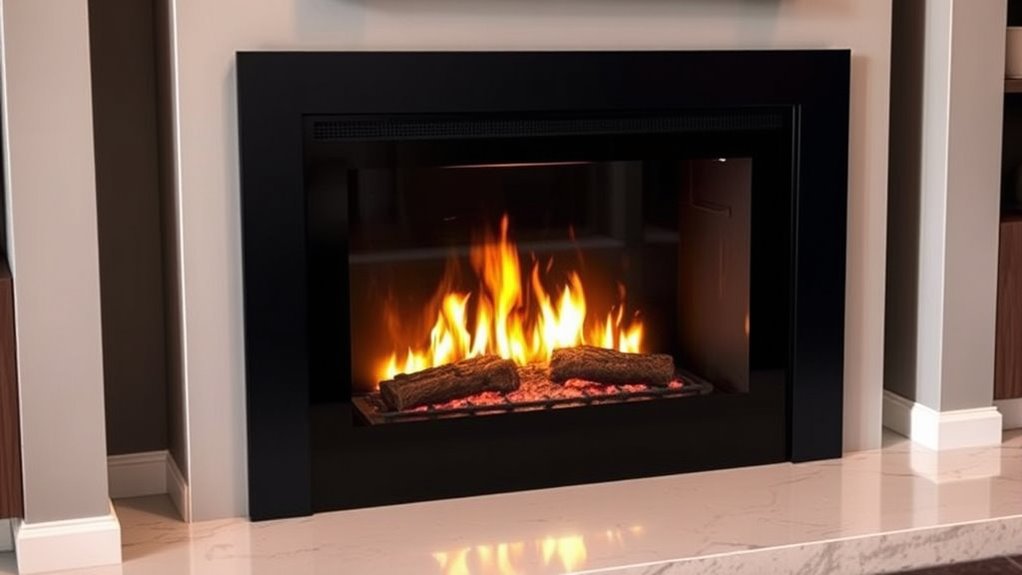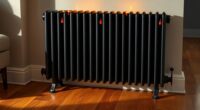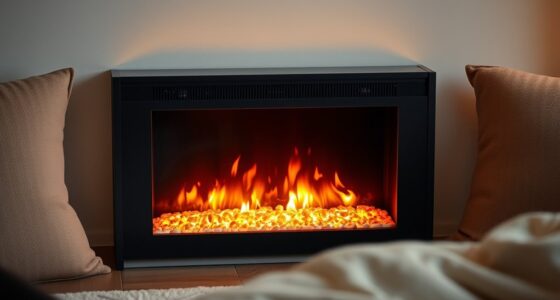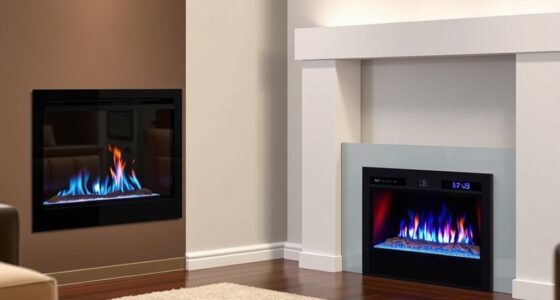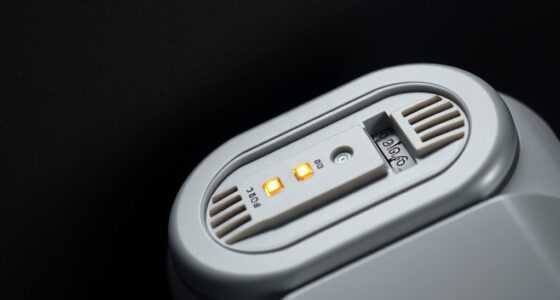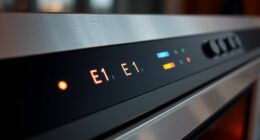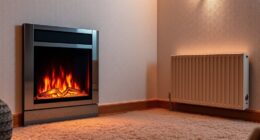No, electric fireplaces do not produce carbon monoxide because they generate heat through electricity, not combustion. Since there’s no burning of fuel or gases, there’s no risk of CO leaks or dangerous fumes. This makes electric fireplaces a safer choice, especially in homes without proper ventilation. They provide heat without the risks associated with traditional fireplaces. If you want to learn more about their safety features and benefits, keep exploring the details below.
Key Takeaways
- Electric fireplaces do not burn fuel and therefore do not produce carbon monoxide.
- No combustion means no CO leaks or related respiratory hazards.
- They are a safer alternative in homes without proper ventilation systems.
- Proper installation and maintenance ensure safety, but CO production is not a concern.
- Unlike traditional fireplaces, electric units eliminate the risk of carbon monoxide poisoning.

Electric fireplaces are often praised for being a safe and convenient alternative to traditional wood or gas fireplaces, but many people wonder if they pose any risks related to carbon monoxide. Unlike their combustion-based counterparts, electric fireplaces do not burn fuel, so they don’t produce this dangerous gas. However, understanding safety considerations and installation requirements remains essential to guarantee your home remains safe and that you’re getting the benefits these appliances offer.
Because electric fireplaces operate without combustion, they eliminate the risk of carbon monoxide leaks entirely. This makes them a safer choice, especially in homes without proper ventilation or in spaces where installing a traditional fireplace might be risky. Still, safety considerations extend beyond just CO production. You should guarantee that your electric fireplace is installed correctly to prevent electrical hazards. Follow the manufacturer’s installation instructions carefully, and consider professional installation if you’re unsure about electrical wiring or clearance requirements. Proper placement helps avoid fire hazards and ensures the unit functions efficiently.
When it comes to installation requirements, it’s vital to choose a location that can handle the power load and where the unit’s safety features can work at their best. Most electric fireplaces need a dedicated outlet, so avoid plugging them into shared sockets that could overload your circuit. Make sure the area around the fireplace is clear of combustible materials, and maintain proper clearance according to the manufacturer’s guidelines. This not only enhances safety but also guarantees the fireplace’s longevity and performance.
Additionally, inspecting the unit regularly is part of good safety practices. Look for signs of wear, damage, or loose wiring, and always follow the manufacturer’s maintenance recommendations. Unlike traditional fireplaces, electric models don’t require chimney cleaning or ventilation checks, but it’s still wise to keep the surrounding area clean and free of dust or debris that could affect operation.
Frequently Asked Questions
Can Electric Fireplaces Cause Electrical Fires?
Electric fireplaces can cause electrical fires if you neglect proper electrical safety and fire hazard prevention. Overloading outlets, using damaged cords, or faulty wiring increases risks. Always follow manufacturer instructions, keep vents clear, and avoid extension cords. Regularly inspect your unit for signs of wear. By practicing good electrical safety, you reduce the chance of electrical fires and make sure your electric fireplace stays a cozy, safe feature in your home.
Are Electric Fireplaces Energy-Efficient Compared to Traditional Fireplaces?
Ever wonder if you’re really saving energy? Electric fireplaces are usually more energy-efficient than traditional ones, offering significant energy savings and better heating efficiency. They heat only the space you’re in, reducing waste. Plus, there’s no need for venting or burning fuel. So, if you’re looking to cut costs and stay warm, electric fireplaces are a smart, eco-friendly choice that keeps your home cozy without wasting energy.
Do Electric Fireplaces Emit Any Harmful Gases?
Electric fireplaces do not emit harmful gases, so they won’t affect your indoor air quality like traditional fireplaces might. You won’t have to worry about carbon monoxide or other pollutants. However, some models produce electromagnetic emissions, which could impact sensitive individuals. Overall, electric fireplaces are a safe, clean heating option that won’t compromise your indoor air quality or introduce dangerous gases into your home.
How Long Do Electric Fireplace Components Typically Last?
You’ll be surprised how long your electric fireplace components last—typically between 10 to 20 years. The fireplace lifespan depends on usage and maintenance, but most parts like logs, screens, and heaters are built for durability. Ironically, while they don’t produce dangerous gases, neglecting proper care can shorten their component durability. So, enjoy the cozy ambiance without worry, knowing your electric fireplace is designed to endure for years.
Are There Safety Certifications for Electric Fireplaces?
Yes, electric fireplaces have safety certifications that guarantee they meet fire safety and certification standards. When shopping, you should look for UL (Underwriters Laboratories) or ETL (Intertek) marks, which indicate compliance with safety regulations. These certifications verify that the product has been tested for electrical safety, fire risks, and overall reliability. Always choose models with proper safety certifications to ensure safe, worry-free operation in your home.
Conclusion
You might find it surprising, but electric fireplaces produce no carbon monoxide at all. Unlike traditional wood or gas fireplaces, they’re completely safe in that regard. Did you know that over 400 people die annually from carbon monoxide poisoning caused by faulty heating appliances? Choosing an electric fireplace eliminates that risk entirely, giving you peace of mind and cozy warmth without any harmful emissions. So, if safety is your priority, electric fireplaces are definitely the way to go.
